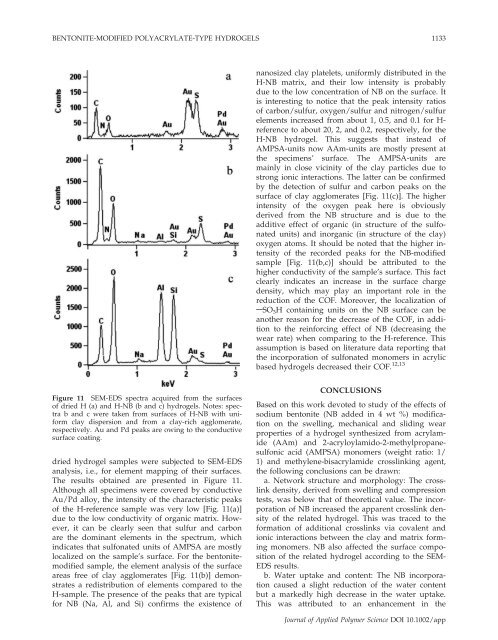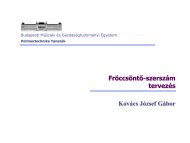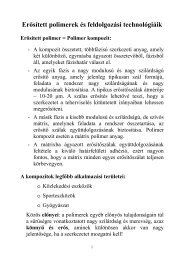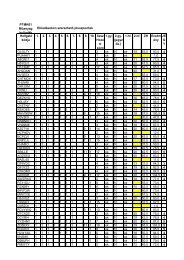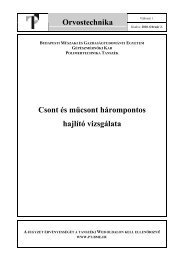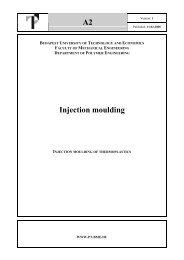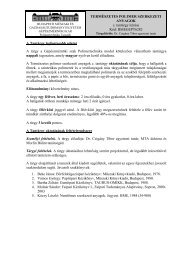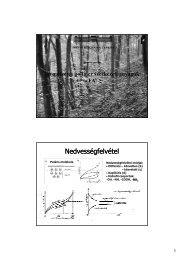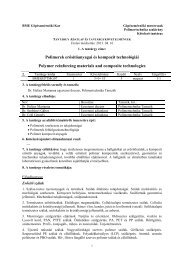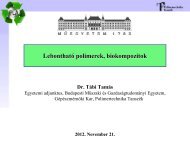Swelling, compression and tribological behaviors of ...
Swelling, compression and tribological behaviors of ...
Swelling, compression and tribological behaviors of ...
Create successful ePaper yourself
Turn your PDF publications into a flip-book with our unique Google optimized e-Paper software.
BENTONITE-MODIFIED POLYACRYLATE-TYPE HYDROGELS 1133nanosized clay platelets, uniformly distributed in theH-NB matrix, <strong>and</strong> their low intensity is probablydue to the low concentration <strong>of</strong> NB on the surface. Itis interesting to notice that the peak intensity ratios<strong>of</strong> carbon/sulfur, oxygen/sulfur <strong>and</strong> nitrogen/sulfurelements increased from about 1, 0.5, <strong>and</strong> 0.1 for H-reference to about 20, 2, <strong>and</strong> 0.2, respectively, for theH-NB hydrogel. This suggests that instead <strong>of</strong>AMPSA-units now AAm-units are mostly present atthe specimens’ surface. The AMPSA-units aremainly in close vicinity <strong>of</strong> the clay particles due tostrong ionic interactions. The latter can be confirmedby the detection <strong>of</strong> sulfur <strong>and</strong> carbon peaks on thesurface <strong>of</strong> clay agglomerates [Fig. 11(c)]. The higherintensity <strong>of</strong> the oxygen peak here is obviouslyderived from the NB structure <strong>and</strong> is due to theadditive effect <strong>of</strong> organic (in structure <strong>of</strong> the sulfonatedunits) <strong>and</strong> inorganic (in structure <strong>of</strong> the clay)oxygen atoms. It should be noted that the higher intensity<strong>of</strong> the recorded peaks for the NB-modifiedsample [Fig. 11(b,c)] should be attributed to thehigher conductivity <strong>of</strong> the sample’s surface. This factclearly indicates an increase in the surface chargedensity, which may play an important role in thereduction <strong>of</strong> the COF. Moreover, the localization <strong>of</strong>ASO 3 H containing units on the NB surface can beanother reason for the decrease <strong>of</strong> the COF, in additionto the reinforcing effect <strong>of</strong> NB (decreasing thewear rate) when comparing to the H-reference. Thisassumption is based on literature data reporting thatthe incorporation <strong>of</strong> sulfonated monomers in acrylicbased hydrogels decreased their COF. 12,13Figure 11 SEM-EDS spectra acquired from the surfaces<strong>of</strong> dried H (a) <strong>and</strong> H-NB (b <strong>and</strong> c) hydrogels. Notes: spectrab <strong>and</strong> c were taken from surfaces <strong>of</strong> H-NB with uniformclay dispersion <strong>and</strong> from a clay-rich agglomerate,respectively. Au <strong>and</strong> Pd peaks are owing to the conductivesurface coating.dried hydrogel samples were subjected to SEM-EDSanalysis, i.e., for element mapping <strong>of</strong> their surfaces.The results obtained are presented in Figure 11.Although all specimens were covered by conductiveAu/Pd alloy, the intensity <strong>of</strong> the characteristic peaks<strong>of</strong> the H-reference sample was very low [Fig. 11(a)]due to the low conductivity <strong>of</strong> organic matrix. However,it can be clearly seen that sulfur <strong>and</strong> carbonare the dominant elements in the spectrum, whichindicates that sulfonated units <strong>of</strong> AMPSA are mostlylocalized on the sample’s surface. For the bentonitemodifiedsample, the element analysis <strong>of</strong> the surfaceareas free <strong>of</strong> clay agglomerates [Fig. 11(b)] demonstratesa redistribution <strong>of</strong> elements compared to theH-sample. The presence <strong>of</strong> the peaks that are typicalfor NB (Na, Al, <strong>and</strong> Si) confirms the existence <strong>of</strong>CONCLUSIONSBased on this work devoted to study <strong>of</strong> the effects <strong>of</strong>sodium bentonite (NB added in 4 wt %) modificationon the swelling, mechanical <strong>and</strong> sliding wearproperties <strong>of</strong> a hydrogel synthesized from acrylamide(AAm) <strong>and</strong> 2-acryloylamido-2-methylpropanesulfonicacid (AMPSA) monomers (weight ratio: 1/1) <strong>and</strong> methylene-bisacrylamide crosslinking agent,the following conclusions can be drawn:a. Network structure <strong>and</strong> morphology: The crosslinkdensity, derived from swelling <strong>and</strong> <strong>compression</strong>tests, was below that <strong>of</strong> theoretical value. The incorporation<strong>of</strong> NB increased the apparent crosslink density<strong>of</strong> the related hydrogel. This was traced to theformation <strong>of</strong> additional crosslinks via covalent <strong>and</strong>ionic interactions between the clay <strong>and</strong> matrix formingmonomers. NB also affected the surface composition<strong>of</strong> the related hydrogel according to the SEM-EDS results.b. Water uptake <strong>and</strong> content: The NB incorporationcaused a slight reduction <strong>of</strong> the water contentbut a markedly high decrease in the water uptake.This was attributed to an enhancement in theJournal <strong>of</strong> Applied Polymer Science DOI 10.1002/app


